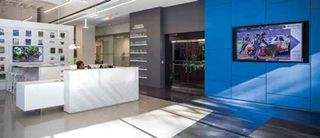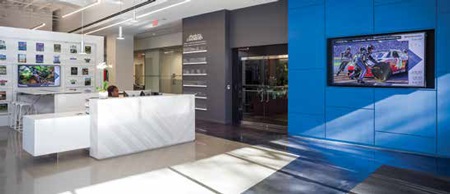Several years of growth have transformed Charlotte into a “new city,” a high technology hub attracting top shelf, Fortune 500 corporations. Unfortunately, a 15-year span since its last renovation had left the Charlotte Chamber with a dated facility and AV systems in need of an upgrade.

Technical Innovation designed an AV makeover for the Charlotte Chamber of Commerce. Shown here is the lobby to the building, complete with new display screens.
Enter Technical Innovation, which recently completed an AV makeover to bring the chamber up to snuff. “Previously, when these chamber members came in to use the space and the chamber’s gear for their presentations, it was not a good representation of the city and often required internal technical support,” said Gary Matthews, TI design engineer. “It was definitely not what these executives were used to. The building was dated, and the AV systems were a combination of consumer and commercial products. You could walk from room to room and never know what to expect; each room was its own island of technology.”
For Matthews and his team, the mission was clear-cut. “It was obvious that they had to get to the same level of tech as their clients,” he noted. “And it had to be easy to use so that members could come in and use the space without any issues. That was a part of the challenge; the chamber does not always have an AV specialist on hand, although they do have a staff that is very comfortable with technology. In addition, the systems had to be accessible by many technologies, such as smartphones and tablets, as well as being collaborative, informative, and complementary to the environment.”
Clearly, what this client sought was a state-of-the-art facility that properly reflected the modern image of the City of Charlotte. “We had not done prior work for them,” Matthews said. “However, we were on their advisory board allowing us to understand the needs of the membership and ultimately design their new systems.”
Under the design services agreement, TI worked with the architect, Gensler, and Turner Construction. “We designed what they wanted and thought they needed,” he added. “The chamber takes donations from members, so part of the budget process for the project was to name various chamber rooms for donors. Major donors purchased pieces of the AV system as part of their gifts. We had to value-engineer the building and the AV, and the client reevaluated what they really needed.”
The result is a new tech face for the facility, one that has built-in scalability. A combinable space, the Wells Fargo and Duke Energy Conference Room, features Crestron’s DigitalMedia 16x16 Media Switcher, four DigitalMedia wall plates, two AirMedia wireless presentation devices, a 3-Series control processor, and two, wall-mounted, 10-inch touchscreen controllers, as well as an iPad with iPad wall dock. It also features two NEC Display Solutions 6,000 lumen laser phosphor projectors, two 137-inch diagonal, 16:10 format, recessed mounted projection screens from Da-Lite, and a robust multi-zone audio system.
The Bank of America Conference Room has a Crestron Digital Media All-In-One Presentation System 300, 10-inch touchscreen controller with table stand, and AirMedia wireless presentation device. It also includes three LED displays used for digital signage and presentations.
“Crestron DigitalMedia was the infrastructure that was utilized,” Matthews said. “A head-end system design featuring DM switcher was chosen as the methodology for distribution of content because it allowed for scalability for changing or adding cards as requirements change.”
In the large conference room, a DMPS system was utilized to keep everything local and minimize installation costs. “Since this room was projected to only scale to include video and audio conferencing, the additional inputs/outputs were factored in,” he added. “As the other meeting spaces are upgraded to include control, the central processor located in the head-end will be utilized to interface with the touchpanels and IP-controllable devices in those rooms instead of bringing in additional processing. This would minimize the cost of implementation.”
Additional products for the project include Visix Creative Services and Visix Ultra-Slim Media Players, and Chief Manufacturing Fusion Series wall mounts for all displays, with all projectors using Chief’s CMS440 mounting systems with CMS472 above-ceiling equipment boxes. Middle Atlantic was also a vendor.
In addition, sound masking throughout the facility and digital signage in multiple lobby locations contribute to the chamber’s new face. “The chamber wanted to use digital signage to be informative and to show visitors what both it and the City of Charlotte are about,” Matthews noted. “The signage had to be easily modifiable for special events and guests.”
“In the end, the facility and the technology are beautiful,” Matthews said. “The chamber is right where it needs to be now. Crestron and NEC were instrumental partners in the project.”
A challenge for TI came in the form of an extremely tight installation timeline, he added. “The chamber staff relocated to the basement during construction and install. Fortunately, there were no glitches; it was all positive and nobody missed a milestone. We worked with Turner to knock it all out.”
As a client, the project called for a business application, but the chamber is, by nature, somewhat promotional, Matthews said. “The chamber is championing the city of Charlotte, and there’s a lot of information to be shared, such as metrics as well as the softer side of the city. It explains Charlotte’s culture and provides information on what that culture has to offer.”
Every AV project involves and requires an understanding of the client’s specific needs and how the system will be used, and by whom. The chamber now has current technology that is user-friendly and easy to operate.
“They do not require a trained AV specialist to set up rooms for the simplest of presentations,” Matthews noted. “The systems are now scalable, so the chamber can look forward to adding capabilities without major changes to the existing systems.”
Karen Mitchell is a freelance writer based in Boulder, CO.













